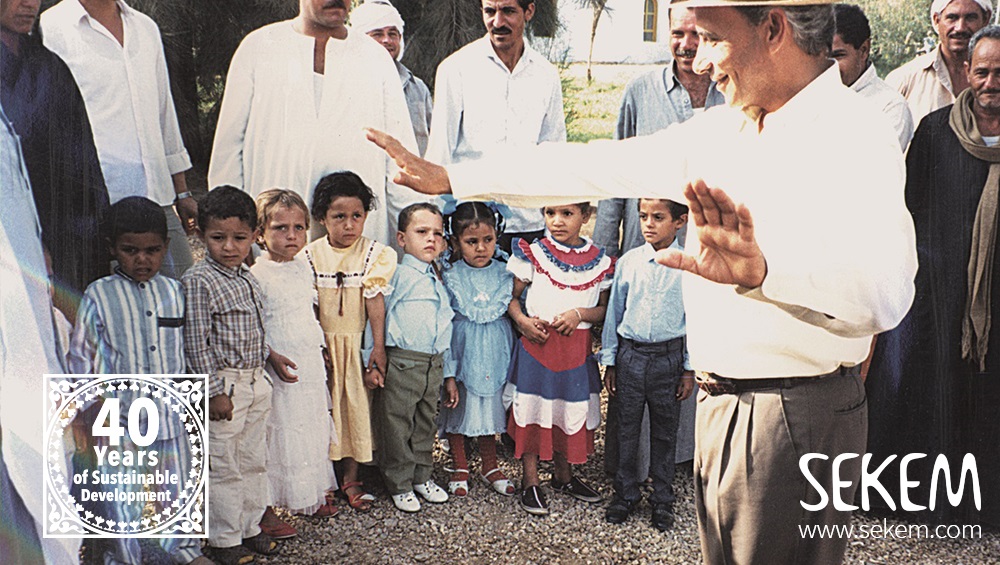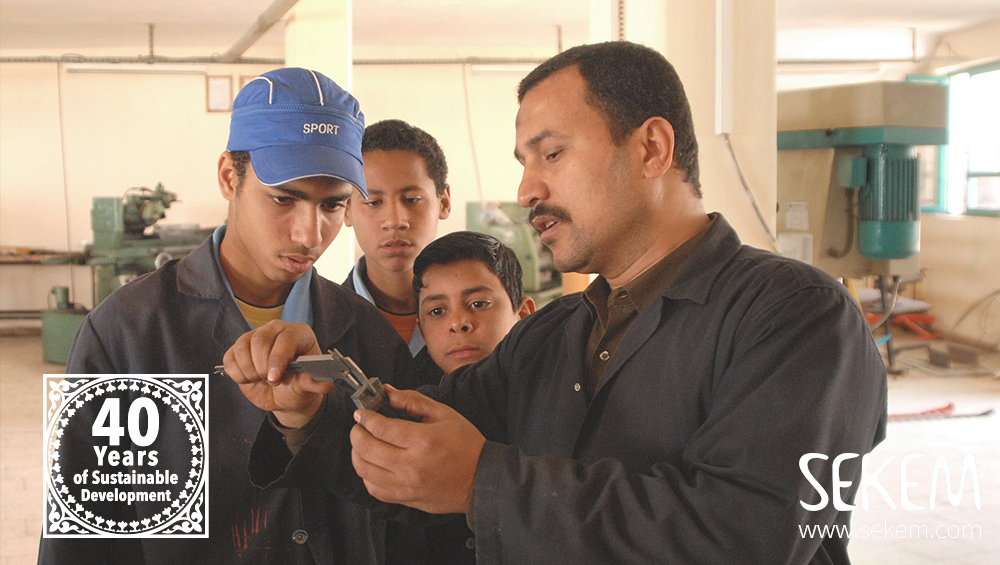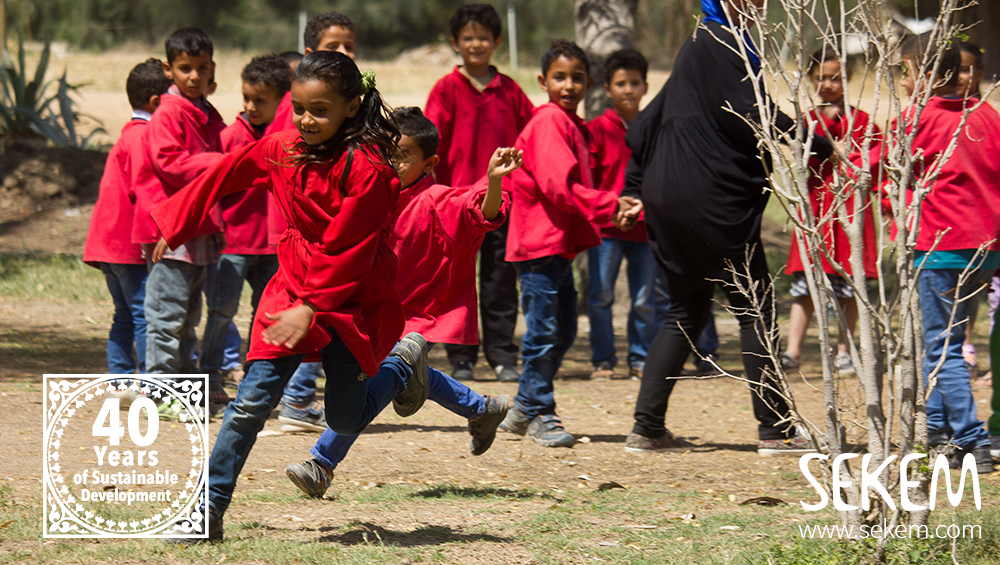Education is one of the major challenges of our time, but also one of the most sustainable development measures. Because only where there is investment in education, there will be people who are learning to take their fate into their own hands with time. Lifelong learning enables people to improve their living conditions as well as to contribute to the development of the community and the country.
SEKEM has always been concerned with developing education very closely from the concrete conditions: for example in the SEKEM Kindergarten, in the SEKEM School or in the Heliopolis University for Sustainable Development. “With the SEKEM School, we are oriented towards the Egyptian school system and want to be an example for other schools – with the Egyptian teachers and the state curriculum,” says Yvonne Floride, who is responsible for the educational and practical training at SEKEM. The key question is always what people need in their respective situations at their respective locations. To work learning, to learn working – this is more than “learning by doing”.
A learning community
From the very beginning, this was the foundation for the SEKEM School, which was established in 1989. Since then, the SEKEM School has been striving for both a continuous curriculum and teacher development. “Every additional time I had, I used for the school construction, also in financial terms,” remembers SEKEM founder Dr. Ibrahim Abouleish. “I organized the funding in a way that the SEKEM companies support the school activities with ten percent of their profits. In addition, I lent money from banks to build the school buildings. We also received financial support from the SEKEM Friends Association Germany,” he says.

At his side always the support of many people: His wife Gudrun Abouleish initially became the school director. Elfriede Werner tirelessly worked to find teachers for teacher training and to raise funds for the necessary furnishings of the school as well as for teaching materials. Together with Professor Dr. Klaus Fintelmann from the Hibernia School in Wanne-Eickel, Germany, as well as with Winfried Reindl and the architect Gerdi Bentele, Dr. Ibrahim Abouleish developed the school concept and models for the school building – a very lively activity for all: “For each class and room, we planned the forms and their coloring as well as the teachers’ rooms, the consultation rooms, the medical rooms, a mosque and a chapel for the Coptic children,” Dr. Abouleish continues.
The SEKEM School is more than just a school
The SEKEM School offers lower, middle and advanced grades for around 300 pupils. It is located on the SEKEM farm, about 60 km northeast of Cairo. Although the SEKEM School is approved by the Egyptian Ministry of Education and based on the Egyptian government curriculum, it also promotes new forms of educational and social interaction. The students represent all social levels and come mainly from the nearby town of Bilbeis or the surrounding rural areas. The school is open for children of all religions and encourages them to live in harmony and to respect the religious practices of each other.
“For us being a teacher means more than teaching the particular subject,” Yvonne Floride
However more precisely, the school is more than just a school in the classical sense: children need a balance between theoretical learning contents and artificial and practical activities, if the schooling is supposed to react to the educational needs of the children. “We undertake additional activities with the pupils: Together we eat in the cafeteria, together we go to the mosque, together we clean the classroom,” says Yvonne Floride. “For us being a teacher means more than teaching the particular subject. We want to meet a whole sphere with the pupils and teachers,” she continues. Since the founding year of the school, the students have been taught in painting, music lessons, sculpture production from clay and wood, handwork and gardening, as well as in classical subjects such as Arabic, English, German, Mathematics, Geography, History, Biology, Chemistry and Physics.

A school – also for teachers
In order to realize the school vision, which addresses not only the intellect, but also the spiritual and physical areas of children, SEKEM has included art and craft into the school curriculum. “Not just as an appendage: we have to bring the teachers into a continuous learning and artistic process in order to satisfy the various age groups and the school,” says Yvonne Floride. Teacher training was included from the outset: an hour every day after school, but also in the process the teachers are accompanied. “The teacher training was very time-consuming,” says Dr. Ibrahim Abouleish. “I have always been less interested in the intellectual talents of the new teachers than in their character traits which have a human influence on the children,” he reveals.
Also Gamal El-Sayed, director of the SEKEM School, recalls this training: “Actually I am an Arabic teacher and suddenly had to communicate with foreigners from Germany, Austria and South Africa, for instance. It was a challenge for me, of course,” he says. “This broadened my mind. We as teachers had to do eurythmy, not just the students. It was something special.”
“The mutual perception, the mutual recognition, the experience of the older pupils, when they see how the younger ones show what they once did – those are very particular educational experiences,” Dr. Ibrahim Abouleish
The artistic influence is also present in the weekly school celebrations on Thursday afternoon. With musical performances and other cultural shows the students reflect their week. Also involved are the SEKEM Kindergarten and the pupils from SEKEMs School for Children with Special Needs. “The mutual perception, the mutual recognition, the experience of the older pupils, when they see how the younger ones show what they once did – those are very particular educational experiences,” says Dr. Ibrahim Abouleish. “They help to promote individualization and independence,” he adds.
Initial difficulties
At first, it took SEKEM had a lot of persuasion to find students for the classes. Today, demand is higher than school places are available. “After a short time, we had the trust of teachers and parents. They realized a special feature about our school; the children do not need any tutoring to pass their examinations,” says Yvonne Floride. Tutoring lessons are an integral part of the Egyptian education system: on the one hand, because the classes are overcrowded, on the other hand, because the teachers often can not live on their salaries and give tutoring lessons to their own pupils in the evening. “The SEKEM schools have a very good reputation,” confirms Gamal El-Sayed.
For the director of the SEKEM School, the SEKEM Initiative is a wonderful example for bridge building. The supporters, who come, work together with the teaching staff on site. Thus mutual learning can arise. But the metaphor also works in a material sense: many supporters have contributed something – be it by bringing their water colours or pencils. Others have donated entire machines or equipment: the Robert Bosch Stiftung financed workbenches for the SEKEM School, the Dieter Kaltenbach Foundation a sawing machine, and the SEKEM Friends Association Switzerland three machines for the wood workshop.
Vocational training – according to the German example
The SEKEM Vocational Training Center was founded in 1997 and has trained about 900 apprentices since the year 2000. Claus Wilhelm Hofmann, former mayor of the German city Biberach an der Riss and current member of the Executive Board of the SEKEM Friends Association Germany, was very committed to the construction of the center at that time. For three years, the town Biberach an der Riss donated 60,000 German Mark yearly, a total of 180,000 German Mark, for the construction of the center in 1997.

At the workshops and at modernly equipped workplaces, the young people complete a three-year training course. This opens up professional opportunities in rural areas and is demanded on the local market. The Center is recognized by the Egyptian government. The practical teaching with four days of practical training and two days of theory lessons is possible in the following areas: carpentry, installation, textile processing, electrical installation, agricultural engineering technology, office administration and welding. Back then, SEKEM developed the necessary curricula for vocational training with the help of today’s German Development Cooperation (GIZ). Through artistic courses, which account for about 20 percent of the training, personality development and creativity are promoted. Thus, SEKEMs vocational training and the associated concept of education is becoming a role model.
Important companions also were Eberhard Kläger, Dieter Schütz, Klaus Charisius and Wilfried Ulrich. They visited SEKEM again and again and supported the Vocational Training Center with their long-time experience. “The people with many years of professional experience and their material contributions made a big difference here – a living example for how cultures can enrich each other,” says Gamal El-Sayed. “Without the supporters we would not have been able to do it,” adds Yvonne Floride.
The SEKEM Initiative has shaped many biographies,” Yvonne Floride
More practice is impossible
From the beginning, SEKEM has attached the vocational training to its own companies: trainees not only learn in the training workshops but also on real conditions by implementing the orders of the companies. “They receive a good education, which is practice-oriented and very much demanded,” says Yvonne Floride. For example, the need in the surrounding villages is so big that the graduates of the electrical installation find work immediately. “As a result, the SEKEM Initiative has shaped many biographies,” she adds.
The weakness of the training initially was to find well-trained teachers. But there, too, the external support has become very useful and perceivable. “As the volunteers have shown trainers how to work, the training facilities have become very professional over time,” the German who came to SEKEM more than 30 years ago says. “In the meantime, we have been able to fill this gap – for example, with a graduate who is now an instructor in the training workshops,” Yvonne Floride continues, while speaking about Moahmmed Mo’min. The former SEKEM trainee and graduate has acquired an additional certificate after completing his mechanics training and is now able to train the apprentices. “That’s what we hope for for all the workshops. In the carpentry workshop, we have also achieved this,” she says.
“Through the personality formation and the integration of handicraft and art into the curriculum, the pupils develop the love to develop themselves”, Gamal El-Sayed
Love to learn
Whether at the School or the Vocational Training Center: “Through the personality formation and the integration of handicraft and art into the curriculum, the pupils develop the love to develop themselves”, Gamal El-Sayed summarizes SEKEMs educational impulse. To this extent, education, as understood in SEKEM, is to create awareness and intensification of the relationship of human being to his environment, to his living conditions, and so development arises. This ethical, cultural and philosophical world of ideas, which is always being worked on, moves him. “The soul which lives in the ideas attracts people,” he adds.
Christina Büns
Get to know Gamal El-Sayed, director of SEKEM School
40 Years on the Road: Impossible Without Women
SEKEM not only celebrates its 40th anniversary but also decades of stories with friends and partners

